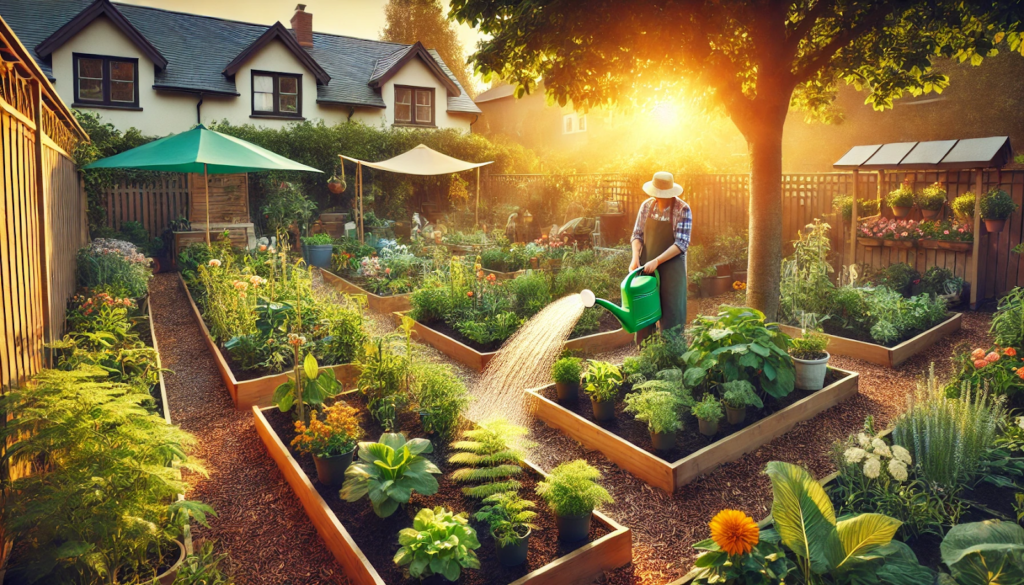Summer is a time of explosive plant growth—but it also brings challenges like extreme heat, drought, and increased pest pressure. To help your plants not only survive but thrive, you need a solid plan for summer care that balances water, nutrients, shade, and proactive maintenance.
In this article, we’ll cover the best strategies to keep your summer garden productive, vibrant, and healthy, even during the hottest days of the year.
1. Water Smart, Not Just Often
During hot weather, efficient watering becomes crucial. Instead of frequent light watering, aim for deeper, less frequent sessions.
Best Practices:
- Water early in the morning to reduce evaporation
- Focus water at the base of plants, not the leaves
- Use drip irrigation or soaker hoses for consistent moisture
- Water deeply once or twice per week depending on rainfall and soil type
Avoid watering during the hottest part of the day, which wastes water and can stress plants.
2. Use Mulch to Retain Moisture
Mulch is one of the most effective tools in summer gardening. It keeps soil cool, reduces evaporation, and suppresses weeds.
Recommended Mulch Materials:
- Straw (without seeds)
- Shredded leaves
- Wood chips
- Grass clippings (dry and thin layers)
Apply 2 to 3 inches of mulch around plants, keeping it a few inches away from stems to avoid rot.
3. Provide Shade for Sensitive Plants
Some plants, especially leafy greens, herbs, and tender flowers, struggle in extreme heat.
How to Shade:
- Use shade cloth over beds during peak afternoon hours
- Plant taller crops (like corn or sunflowers) to shade smaller ones
- Use bamboo screens, old sheets, or floating row covers
Shading reduces plant stress, prevents sunscald, and can extend the harvest of cool-season crops.
4. Feed Plants with Light, Regular Fertilization
Summer heat speeds up plant metabolism, so many crops need extra nutrients.
Tips:
- Use a diluted liquid fertilizer every 2–3 weeks for heavy feeders like tomatoes and cucumbers
- Apply compost tea or fish emulsion for a natural boost
- Avoid over-fertilizing, which can burn roots or lead to excessive leaf growth
Slow-release organic fertilizers are a great option for steady support.
5. Prune and Deadhead Regularly
Keeping your plants trimmed encourages airflow, prevents disease, and promotes continued blooming.
Key Tasks:
- Deadhead spent flowers to stimulate new blooms
- Prune lower tomato leaves to prevent fungal issues
- Cut back leggy herbs like basil and mint to encourage fuller growth
- Remove yellowing leaves or pest-damaged foliage promptly
Don’t over-prune in hot weather; focus on airflow and problem areas.
6. Watch for Pests and Diseases
Summer is peak time for pests like aphids, spider mites, and caterpillars, as well as diseases like powdery mildew and blight.
Prevention and Treatment:
- Inspect plants every few days
- Spray with neem oil or insecticidal soap at the first sign of pests
- Introduce beneficial insects like ladybugs
- Keep leaves dry by watering at the soil level
- Space plants appropriately to improve air circulation
Early detection and action are key to avoiding major problems.
7. Succession Plant for Continuous Harvests
Take advantage of summer’s long growing season by planting new crops every few weeks.
Great Options for Summer Succession:
- Lettuce
- Bush beans
- Radishes
- Carrots
- Basil
Staggered plantings ensure a steady supply of produce and maximize space usage.
8. Harvest Frequently and Generously
Harvesting regularly encourages plants to continue producing.
Tips:
- Pick vegetables like zucchini, cucumbers, and beans when young and tender
- Remove overripe fruit to prevent disease and attract fewer pests
- Store excess harvest in a cool, shaded area or preserve it by freezing or drying
For flowers, cut early in the morning for the longest vase life.
9. Adjust for Drought or Water Restrictions
In areas with limited water access, make your garden more drought-resilient.
Strategies:
- Prioritize watering for fruiting and root crops
- Group plants by water needs (hydrozoning)
- Replace thirsty lawn areas with native plants or groundcovers
- Reuse greywater (like rinse water from vegetables) where allowed
Choose drought-tolerant crops like Swiss chard, okra, rosemary, and cherry tomatoes.
10. Maintain Tools and Infrastructure
Hot weather can also wear out tools and equipment quickly.
Mid-Summer Checklist:
- Sharpen pruners and shears
- Repair or replace damaged hoses
- Adjust trellises and plant supports
- Check irrigation lines for leaks
Keep your workspace clean and organized to reduce time and effort.
Final Thoughts: Thrive, Not Just Survive
A thriving summer garden depends on preparation, observation, and consistent care. By using these proven strategies—efficient watering, shading, mulching, and pest control—you can keep your plants healthy, maximize your harvest, and enjoy your time in the garden even on the hottest days.
With a few smart adjustments, your summer garden will not just survive the heat—it will flourish in it.






